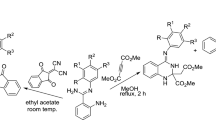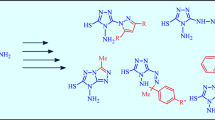Abstract
A novel design and efficient protocol for the synthesis of new class of 6-substituted quinazoline-2-thiols is reported. The derivatization of the thioquinazolines is achieved in a strategic manner using 2-aminobenzylamine. The functionalization of the aniline followed by construction of the heterocyclic ring provides a facile way to synthesize these bifunctional quinazolines.
Graphical abstract














Similar content being viewed by others
References
Chandregowda V, Kush AK, Chandrasekara Reddy G (2009) Synthesis and in vitro antitumor activities of novel 4-anilinoquinazoline derivatives. Eur J Med Chem 44:3046–3055. https://doi.org/10.1016/j.ejmech.2008.07.023
Al-Rashood ST, Aboldahab IA, Nagi MN, Abouzeid LA, Abdel-Aziz AA, Abdel-Hamide SG, Youssef KM, Al-Obaid AM, El-Subbagh HI (2006) Synthesis, dihydrofolate reductase inhibition, antitumor testing, and molecular modeling study of some new 4(3H)-quinazolinone analogs. Bioorg Med Chem 14:8608–8621. https://doi.org/10.1016/j.bmc.2006.08.030
Vasdev N, Dorff PN, Gibbs AR, Nandanan E, Reid LM, Neil JPO, VanBrocklin HF (2005) Synthesis of 6-acrylamido-4-(2-[18F] fluoroanilino) quinazoline: a prospective irreversible EGFR binding probe. J Labelled Compd Radiopharm 48:109–115. https://doi.org/10.1002/jlcr.903
Wakeling AE, Guy SP, Woodburn JR, Ashton SE, Curry BJ, Barker AJ, Gibson KH (2002) ZD1839 (Iressa): an orally active inhibitor of epidermal growth factor signaling with potential for cancer therapy. Cancer Res 62:5749–5754
Rohini R, Muralidhar Reddy P, Shanker K, Hu A, Ravinder V (2010) Antimicrobial study of newly synthesized 6-substituted indolo[1,2-c]quinazolines. Eur J Med Chem 45:1200–1205. https://doi.org/10.1016/j.ejmech.2009.11.038
Antipenko L, Karpenko A, Kovalenko S, Katsev A, Komarovska-Porokhnyavets E, Novikov V, Chekotilo A (2009) Synthesis of new 2-thio- [1,2,4]triazolo[1,5-c]quinazoline derivatives and its antimicrobial activity. Chem Pharm Bull 57:580–585. https://doi.org/10.1248/cpb.57.580
Jatav V, Kashaw S, Mishra P (2008) Synthesis and antimicrobial activity of some new 3–[5-(4-substituted)phenyl-1,3,4-oxadiazole-2yl]-2-styrylquinazoline-4(3H)-ones. Med Chem Res 17:205–211. https://doi.org/10.1007/s00044-007-9054-3
Aly AA (2003) Synthesis of novel quinazoline derivatives as antimicrobial agents. Chin J Chem 21:339–346. https://doi.org/10.1002/cjoc.20030210324
Kunes J, Bazant J, Pour M, Waisser K, Slosarek M, Janota J (2000) Quinazoline derivatives with antitubercular activity. Farmaco 55:725–729. https://doi.org/10.1016/S0014-827X(00)00100-2
Alagarsamy V, Solomon VR, Dhanabal K (2007) Synthesis and pharmacological evaluation of some 3-phenyl-2-substituted-3H-quinazolin-4-one as analgesic, anti-inflammatory agents. Bioorg Med Chem 15:235–241. https://doi.org/10.1016/j.bmc.2006.09.065
Baba A, Kawamura N, Makino H, Ohta Y, Taketomi S, Sohda T (1996) Studies on disease-odifying antirheumatic drugs: synthesis of novel quinoline and quinazoline derivatives and their anti-inflammatory effect. J Med Chem 39:5176–5182. https://doi.org/10.1021/jm9509408
Lakhan R, Singh OP, Singh JRL (1987) Studies on 4(3H)-quinazolinone derivatives as anti-malarials. J Indian Chem Soc 64:316–318. https://doi.org/10.1002/chin.198808219
Rawal RK, Tripathi R, Katti SB, Pannecouque C, De Clercq E (2008) Design and synthesis of 2-(2,6-dibromophenyl)-3-heteroaryl-1,3-thiazolidin-4-ones as anti-HIV agents. Eur J Med Chem 43:2800–2806. https://doi.org/10.1016/j.ejmech.2007.12.015
Li H, Huang R, Qiu D, Yang Z, Liu X, Ma J, Ma Z (1998) Synthesis and bioactivity of 4-quinazoline oxime ethers. Prog Nat Sci 8:359–365
Nandy P, Vishalakshi MT, Bhat AR (2006) Synthesis and antitubercular activity of Mannich bases of 2-methyl-3H-quinazolin-4-ones. Indian J Heterocycl Chem 15:293–294
Jadhavar Pradeep S, Dhameliya Tejas M, Vaja Maulikkumar D, Kumar Dinesh, Sridevi Jonnalagadda Padma, Yogeeswari Perumal, Sriram Dharmarajan, Chakraborti Asit K (2016) Synthesis, biological evaluation and structure–activity relationship of 2-styrylquinazolones as anti-tubercular agents. Bioorg Med Chem Lett 26:2663–2669. https://doi.org/10.1016/j.bmcl.2016.04.012
Ahmad Akil, Mohd-Setapar Siti Hamidah, Chuong Chuo Sing, Khatoon Asma, Wani Waseem A, Kumar Rajeev, Rafatullah Mohd (2015) Recent advances in new generation dye removal technologies: novel search for approaches to reprocess wastewater. RSC Adv 5:30819. https://doi.org/10.1039/C4RA16959J
Cao SL, Feng YP, Jiang YY, Liu SY, Ding GY, Li R (2005) Synthesis and in vitro antitumor activity of 4(3H)-quinazolinone derivatives with dithiocarbamate side chains. Bioorg Med Chem Lett 15:1915–1917. https://doi.org/10.1016/j.bmcl.2005.01.083
Mishra A, Srivastava K, Tripathi R, Puri SK, Batra S (2009) Search for new pharmacophores for antimalarial activity. Part III: synthesis and bio evaluation of new 6-thioureido-4-anilinoquinazolines. Eur J Med Chem 44:4404–4412. https://doi.org/10.1016/j.ejmech.2009.06.001
Abdulrahman M, Al O, Sami G, Abdel H, Hassan A, El K, Alaa AM, Abdel-Aziza S, Adel E, Hamad A, Al K, Hussein I, El-Subbagh (2009) Substituted quinazolines, part 3. Synthesis, in vitro antitumor activity and molecular modeling study of certain 2-thieno-4 (3H)-quinazolinone analogs. Eur J Med Chem 44:2379–2391. https://doi.org/10.1016/j.ejmech.2008.09.015
François-Rene A, Lisianne D, Stephane F, Alexandra T, Valerie T, Thierry B (2003) Microwaves in drug discovery and multi-step synthesis. Mol Divers 7:273–280. https://doi.org/10.1023/B:MODI.0000006860.56083.2b
Zheng XC, Kui D, Jun X (2004) A highly efficient way to capture CX2 (O, S) mildly in reusable Reils at atmospheric pressure. Green Chem 16:3142–3148. https://doi.org/10.1039/C4GC00190G
Nilsson Jakob, Gidlöf Ritha, Nielsen Elsebet Østergaard, Liljefors Tommy, Nielsen Mogens, Sterner Olov (2011) Triazoloquinazolinediones as novel high affinity ligands for the benzodiazepine site of GABAA receptors. Bioorg Med Chem 19:111–121. https://doi.org/10.1016/j.bmc.2010.11.050
Mukarramov NI, Urakov BA, Shakhidoyatov KM (2006) Oxidative cyclo condensation of cyclic thio(seleno)ureas. Electronic effects of the substituents and the medium from Chemistry of Heterocyclic compounds. Chem Heterocycl Compd 42:540–545. https://doi.org/10.1007/s10593-006-0123-1
Shikhaliev KS, Zolotykh KV, Cherkasova ND, Solovev AS (2004) New synthetic approaches to 6(7)-4-methyl-2-sulfanylquinazolines and their transformations. Russian J Gen Chem 74:1591–1596. https://doi.org/10.1007/s11176-005-0063-y
Kennewell PD, Scrowston RM (1986) Investigations into a by-product from the reaction of 2-amino-5-methylbenzoic acid with ammonium thiocyanate. J Chem Res 7:232–233. https://doi.org/10.1002/chin.198646246
Gillian MK (2014) Afatinib: a review of its use in the treatment of advanced non-small cell lung cancer. Drugs 74:207–221. https://doi.org/10.1007/s40265-013-0170-8
Helmout M, Byoung CC, Martin CM, Flavio S (2014) A comprehensive review of the preclinical efficacy profile of the ErbB family blocker afatinib in cancer. Naunyn Schmiedebergs Arch Pharmacol 387:505–521. https://doi.org/10.1007/s00210-014-0967-3
Dhillon S (2015) Gefitinib: a review of its use in adults with advanced non-small cell lung cancer. Target Oncol 10:153–170. https://doi.org/10.1007/s11523-015-0358-9
Miao T, Wang L (2008) Regioselective synthesis of 1,2,3-triazoles by use of a silica-supported copper(I) catalyst. Synthesis 3:363–368. https://doi.org/10.1055/s-2008-1032037
Satya Karuna P, Naresh Kumar K, Reddy MRP (2016) Oxone mediated oxidation of 2-(aryl/alkyl thio) quinazolines: a green approach. J Chem Sci 129:203–210. https://doi.org/10.2174/2213346105666180605123417
Satya Karuna P, Naresh Kumar K, Reddy MRP (2018) Microwave-promoted synthesis of s-substituted quinazoline derivatives using 1,4-dihydroquinazoline-2-thiol. Lett Drug Des Discov 15:583–589. https://doi.org/10.2174/1570180814666170823160851
Satya Karuna P, Ramana Murthy RVV, Reddy MRP, Naresh Kumar K, Srinivas K (2014) Tandem one pot and efficient method for the palladium-reagent-catalyzed cross-coupling of quinazoline thiols. J Heterocyclic Chem 53:784–788. https://doi.org/10.1002/jhet.2510
Acknowledgements
One of the authors (PSK) is thankful to the Jawaharlal Nehru Technological University, Kakinada, and GITAM University, Hyderabad, for providing laboratory and other facilities.
Author information
Authors and Affiliations
Corresponding authors
Ethics declarations
Conflict of interest
The author(s) confirm that this article content has no conflict of interest.
Electronic supplementary material
Below is the link to the electronic supplementary material.
Rights and permissions
About this article
Cite this article
Pulakhandam, S.K., Katari, N.K. & Jonnalagadda, S.B. Design and synthesis of novel 6-substituted quinazoline-2-thiols. Mol Divers 23, 351–360 (2019). https://doi.org/10.1007/s11030-018-9874-8
Received:
Accepted:
Published:
Issue Date:
DOI: https://doi.org/10.1007/s11030-018-9874-8




